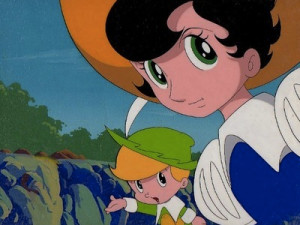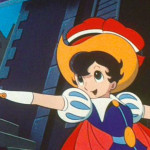Princess Knight (Anime)
Also known as リボンの騎士 (Ribon no Kishi)
The most well-known animated version of Princess Knight is the 52-episode 1967-68 television series, one of the fist animated television programs aimed at a young female audience, which was broadcast on Fuji TV from April 2, 1967 to April 7, 1968. However, the list also includes the 1966 broadcast pilot and the 1999 Tezuka Osamu World short.
What it’s about
Set in a medieval fairy-tale type setting, Princess Knight (1967-68) tells the story of young Princess Sapphire. When a mischievous cherub named Tink accidentally gives Sapphire a second heart, the young girl is born with both the brave and adventurous blue heart of a boy as well as the loving and caring red heart of a girl. Although very similar in style and plot to the Nakayoshi Edition of the manga, there are significant differences between the manga remake and the 1967-68 television series. Many of the TV episodes are original stories and do not have corresponding manga chapters. Also the TV show makes a drastic departure from the original storyline about two thirds of the way through; the tone of the show becomes much more serious as the main characters must put aside their differences in order to fight off foreign invaders seeking to conquer the kingdoms of Goldland, Silverland and Charcoalland.
What you should know
Following up on the earlier success of animated televisions series such as the black & white Astro Boy (1963-66), the full-colour Jungle Emperor (1965-66), and it’s sequel Onward, Leo! (1966-67), Mushi Productions decided Princess Knight (1967-68) would be the next Tezuka work to be animated. Originally planned as part of the “Mushi Pro World” television series – Japan’s first 60-minute animated television program based on the same popular anthology format used by Walt Disney Company – the concept was rejigged in the hopes of an overseas sale to the American television giant National Broadcasting Company (NBC). Produced in November 1966, the broadcast-ready pilot episode was animated in full-colour, with a run time of 28 minutes 40 seconds.
Although never broadcast on television, the pilot film was extremely faithful to the storyline of the Princess Knight manga and featured elaborately structured camera shots.
According to Fred Ladd, in his book, Astro Boy and Anime Come to the Americas, NBC declined to purchase Princess Knight (1967-68) primarily because of the girl-dressed-as-a-boy gender bending aspects of the series. NBC was concerned that “station buyers who would either buy, or reject, this series would reject it, on their perception that this series was all about “sex switch” (2009, p. 68).
Despite this setback, Tezuka and Mushi Productions went ahead with the production and the Princess Knight (1967-68) animated television series debuted on Fuji TV on April 2, 1967. One of the fist animated television programs aimed at a young female audience (the only known shōjo anime to precede it was Sally the Witch which began in 1966), Princess Knight (1967-68) was a hit and completed it’s 52-episode run on April 7, 1968.
Despite being declined by NBC and not broadcast on network television in the United States, Princess Knight (1967-68) was acquired by an independent animator-producer named Joe Oriolo. According to Fred Ladd, “Oriolo…changed the name…to Choppy and the Princess, dubbed it in English, and licensed it to independent television stations in the United States” (2009, p. 68).
Upon its completion in 1968, there was no new Princess Knight anime for thirty years until, in 1999, a short 8-minute animated film began being screened exclusively at “300-inch Theater” at Tezuka Osamu World KYOTO. As the first half of a two-segment show, the story of Princess Knight is narrated by the Phoenix – explaining how, despite the evil Duke Duralumin, she believes in a “tomorrow” that is a peaceful and quiet world. Through this segment, the Phoenix tries to convey the message that “the world will never lose the light of the future unless you lose hope”.




